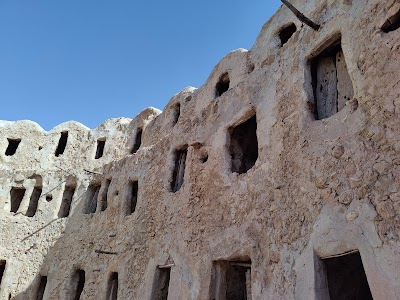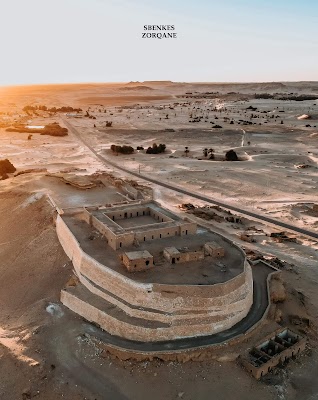Qasr Al-Hajj (قصر الحاج)
Overview
Qasr Al-Hajj: A Historical Oasis in the Heart of Jufra
Nestled in the expansive landscape of the Jufra region in Libya, Qasr Al-Hajj is not just a site of historical significance; it is a testament to the rich tapestry of Libyan culture and history. This ancient fortress, often referred to as a "qasr" or castle, stands as a beacon of resilience and architectural grandeur amid the arid desert. The structure itself is a classic example of traditional Libyan architecture, featuring thick mud-brick walls that have withstood the test of time, embodying the ingenuity of the ancient builders who sought to create a refuge in this harsh environment.
Visitors to Qasr Al-Hajj will find themselves stepping back in time as they explore its intricate passageways and spacious courtyards. The fortress was originally constructed to serve as a caravanserai, a resting place for travelers and traders navigating the Sahara Desert. Its strategic location made it a vital stop for those journeying across the vast sands, ensuring the safety and comfort of weary travelers. Today, as you walk through its corridors, you can almost hear the echoes of history, imagining the bustling life that once filled these walls with stories of trade, culture, and camaraderie.
Architectural Marvels and Cultural Significance
The architecture of Qasr Al-Hajj is particularly captivating, showcasing unique features such as arched doorways, intricate plasterwork, and decorative motifs that reflect the artistic styles of the time. The fortress is surrounded by a series of watchtowers, which not only served a defensive purpose but also offered panoramic views of the surrounding landscape. This vantage point was crucial for monitoring the movements of potential threats in the region, further underscoring the importance of the qasr in the historical context of Jufra.
For foreign travelers, visiting Qasr Al-Hajj offers a rare glimpse into the local way of life and the enduring traditions of the Libyan people. The site is often less frequented by tourists compared to more popular destinations, providing an authentic experience that allows for intimate exploration. Engaging with the local community can enrich your visit, as many residents are eager to share stories of their heritage and the significance of the qasr in their lives.
Practical Information for Visitors
When planning your visit to Qasr Al-Hajj, it’s essential to consider the best time to explore this remarkable site. The cooler months of late autumn and early spring are ideal, as the temperature during the summer can be quite extreme. There are no formal entry fees, but it is advisable to respect the site and its surroundings by keeping it clean and adhering to any local customs.
As you embark on your journey to Qasr Al-Hajj, be sure to prepare for the trip with adequate water and sun protection. The surrounding landscape is breathtaking, so consider bringing a camera to capture the stunning sunset views that can be seen from the fortress’s heights. Whether you're a history buff, an architecture enthusiast, or simply a curious traveler, Qasr Al-Hajj represents a unique chapter in Libya’s rich history that is not to be missed.
In conclusion, Qasr Al-Hajj is more than just a landmark; it is a portal to the past, offering insights into the resilience and spirit of the Libyan people. As you wander through its storied halls, you'll discover an allure that goes beyond its physical structure, inviting you to connect with the ancient narratives that continue to shape the identity of this remarkable North African nation.





